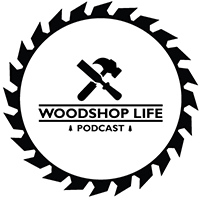Support us on Patreon: https://www.patreon.com/woodshoplife
Guys Questions:
1) Hi guys , I have been pondering this for a while and just wanted some other perspectives, if you don’t mind. Question, how would you go about veneering a cabriole leg, something in the Louis 14th era. I haven’t found anything on how it was done (some kind of hammer veneering I’m guessing)
I want to do this for a personal project and would appreciate any insights.
Cheers, joey chalk.
2) I have an older coffee table. Nicely made from oak. It is finished in a dark brown stain and then covered in a glossy varnish (at least I think it’s a stain/varnish combination). I like the coffee table, but the finish is not my style and would prefer it to be matt and/or lighter in color .
I guess the easiest work is to just get it matt by lightly sanding it and refinishing it with matt varnish? Getting the color lighter will require more sanding and more work?
What would your approach be? Any suggestions for stains, oils or another finishes that look natural/lighter?
Thank you!
Bart (from Belgium)
Seans Questions:
1) I was wondering your thoughts about putting a wax finish over danish oil. I’ve heard that it’s more upkeep and unnecessary. I’ve finished a few small gift boxes made out of walnut with danish oil but I feel that I don’t quite get the patina I’m looking for. Do you have a favorite finish for small gift boxes? – Scott
2) Hi Guys,
Thanks for putting together such a great podcast! I know that Guy has a 12″ jointer/planer combo machine and believe Huy and Sean may also. I’ve asked Guy a few questions about his machine in the past and he has been kind enough to answer and even do a review of his machine…thanks Guy! I am looking to eventually purchase a similar machine to Guy’s, but the Canadian importer I will purchase from offers both 12″ and 16″ models. Has there been a time that you’ve wished for a machine larger than 12″? Obviously the 16″ is more money, an extra $1000 or so. Would you go for the 16″, or is 12″ more than enough? – Kreg
Huys Questions:
1) I always here people talk about how you can’t trust the square you just bought to be square. Well, if nothing I have is square, then how the hell do I know what is actually square? This question of what is really square and what is not has been screwing with me for a couple of years now. So I just pass over it and get my stuff close enough…. which, of course, makes for its own set of headaches….PyratWoodworking
2) Loving the podcast guys! My question is regarding third party upgrades to bigger machines. Recently found a used Jet JJ-6CSX on marketplace for pretty cheap ($550) and the commercial contractor selling it must not have used it because it’s in amazing condition. That being said, I’m tempted to upgrade the cutter head. Although the knives are functional and fine, I know that a helical head has a lot more long term benefits.
So my question is: Have any of you upgraded a cutterhead from a third party vendor before? If so, how did it work out? I have also only been able to find a couple of options from Grizzly or Byrd. Are there others out there that also make something that can fit this model and what should I be weary of when looking?
As always thanks for all you guys do.
Joey
Winter Wolf Woodworking
Our Social Picks:
Sean: @StudioCSH
Guy: @retiredwithwood
Huy: @fernwehwoodworking
